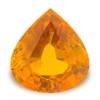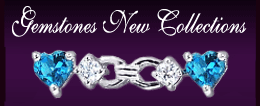Glittering Stones » Gemstone Reports » European Gemological Laboratory Report(EGL)
European Gemological Laboratory
Origins:

The Internationally recognized Institute European Gemological Laboratory (EGL) was founded in Belgium more than 30 years ago. In 1977, the EGL established its North American headquarters in New York City. The European Gemological Laboratory is credited with introducing new approaches to grading diamonds, including the grading of diamonds less than one carat in size. In 1997, EGL unveiled the "SI3" designation for grading diamond clarity, a standard that the world diamond community has come to embrace. Thanks to its commitment to gemological excellence and more than a quarter century of experience, the EGL is one of the world’s most prestigious laboratories.
MethodologyAn European Gemological Laboratory grading report is based on thorough scrutiny of every facet and detail of the diamond being considered. Each diamond passes through the hands of at least eight professionals, four of whom are trained gemologists. |
EGL Diamond Certification Weight and measurement are recorded, and culet and girdle thickness are noted. Color is graded in scientifically calibrated lighting conditions, and the stone is compared to a set of master diamonds with known color grades. Three color graders must agree before the diamond is assigned a color grade. Clarity is determined by graders who use a zoom binocular microscope to inspect every facet of the diamond for inclusions (internal) and blemishes (external) that could affect clarity. Locations of inclusions are plotted on a diamond diagram. Polish and symmetry are graded based on a careful inspection of the diamond’s cut finish. |
The EGL Group expertise and reputation are based on:State-of-the-art technology The largest variety of gemological services The largest laser inscription service in the industry Cutting-edge research Internet accessible certificate verification and Account Status Education for the jewelry trade and consumers The four factors that are used to determine the quality and value of a diamond are called The Four C's. The essential 4C’s are Cut, Color, Clarity, and Carat weight. It is the combination of these four “C’s” that determines a diamond’s value. By changing any of the characteristics, you can dramatically affect the diamond’s value, all other factors being equal. |
Cut: The only one of the 4Cs that is within our control is a diamond's cut. Cut is the result of a craftsman’s skill in transforming a rough diamond into a breathtaking gem. A diamond has facets that allow light to enter it, become refracted, and exit in a rainbow of colors. So it follows that a better cut diamond does a better job of dazzling us with its beauty. Here’s the ‘secret’ to how a diamond sparkles. Many gemologists consider cutting quality to be the most important diamond characteristics because even if a diamond with a poor cut will have reduced brilliance. Cut is not a shape, i.e. pear, round, oval. Cut refers to the quality of the proportioning, polish and symmetry. The cut of a diamond—its roundness, its depth and width, and the uniformity of the facets—all determine the ability to exhibit brilliance. The width and depth have the greatest effect on how light travels within a diamond, and how it exits in the form of brilliance. As cutting can be confusing subject, ask your professional jeweler about “ideal” proportions and request a cut grading report from a major independent gemological laboratory alike EGL. |
Clarity:A diamond’s degree of clarity scale is determined by internal and external characteristics.  Internal characteristics are called inclusions. The most common inclusions are crystals, clouds and feathers. Crystals are minerals tracked inside a diamond. Clouds are hazy areas typically created by crystals too tiny too see under 10x magnification. Feathers break in stone. External characteristic, or surface irregularities, are called as blemishes. A scratch on a diamond’s surface is one type of blemish.  |
Measuring Diamond Clarity:When we speak of a diamond's clarity, we are referring to the presence of identifying characteristics on and within the stone. While most of these characteristics are inherent qualities of the rough diamond and have been present since the earliest stages of the crystal's growth below ground, a few are actually a result of the harsh stress that a diamond undergoes during the cutting process itself. Diamond clarity is graded using ten-power (10x) magnification, as most of the inclusions are invisible to unaided eye. Type, position, and size of the inclusions are crucial to determine the clarity. Inclusions in the table, the heart of the stone will significantly downgrade diamonds clarity. |
Diamond Clarity Grades:Flawless (FL) - Shows no inclusions or blemishes when viewed with 10x magnification. Internally Flawless (IF) – Contains no inclusions under 10 x magnifications, minor blemishes tolerated. Very very Slight Included (VVS1 & VVS2) – Contains minute inclusions that are extremely difficult to locate under 10x magnifications. Very Slight Included (VS1 & VS2) – Contains minute inclusions, such as clouds, crystals, or feathers, which a difficult to locate 10x magnification. Slightly Included (SI1 & SI2) – Noticeable inclusions under 10x magnification, including clouds, knots, crystals, cavities, and feathers. Slightly Included (SI3) – Contains inclusions that are very easy to see with 10x magnification. Grading splits between SI2 and I1. Included (I1, I2, I3) – Contains very obvious inclusions under 10x magnifications. Usually can see with naked eye. Clarity might also impede transparency and affect brilliance. |
Diamond’s Carat Origin:The greater the carat weight, the rarer - and thus more expensive - the diamond. The word carat is taken from the perfectly matched carob seeds that people once used in ancient times to balance scales. So uniform in shape and weight are these little seeds that even today's sophisticated instruments cannot detect more than three one-thousandths of a difference between them.  One Carat à 100 points. Three- Quarter Carats à 75 points. Half Carat à 50 points. Quarter à 25 points. Melee à They weight in at least 0.15 carats and are grouped together.  |
Color:Color describes the amount of color the diamond contains. This can range from colorless to yellow with slight tints of yellow, gray, or brown. Colors can also range from intense yellow to brow, blue, green, pink, and red. These fancy colors are rare and therefore more valuable. Understanding Diamond Color Grading: Many of the systems have been used to grade the diamond color. To eliminate the confusion, the European Gemological Laboratory (EGL) introduced a color grading. The scale begins at D (colorless) and ends at Z (light yellow). The scale starts at D because that letter had not been used previously to classify color. |
How Color Grading Is Performed: Diamond color is difficult to discern when a diamond is viewed face-up. Therefore, the grader turns the diamond facedown against a pure white surface under carefully controlled light. The diamond grader compares the diamond to a so-called master stone to determine color. A master stone is a diamond of a predetermined color that is used for comparison. |
Diamond Color Grades:D (Colorless) - Highest color grade your diamond can achieve. This color emits unequaled brilliance, and is extremely rare. E (Colorless) - Containing minute traces of color. Emits unsurpassed brilliance, and is very rare. F (Colorless) - Minute traces of color can only be detected by a trained gemologist. This is a high-quality color grade. G, H (Near Colorless) - Noticeable color only when compared to higher color grades. Excellent value, as it appears colorless to the untrained eye. I, J (Near Colorless) - Slightly detectable color. Excellent value, as it appears colorless to the eye. K, L, M (Faint Yellow) - Faint color noticeable. Even with the presence of color, diamonds can emit fire and beauty. |
NOVEMBER BIRTHSTONE - CITRINE

COMMEMORATIVE EVENT - 13th Anniversary
KEYWORDS - Success, Abundance, Personal Power
ALSO KNOWN AS - Merchant's stone, Success stone
COLORS - Pale yellow to brown
OCCURRENCE - Brazil
COLOR ZONING - Tiger stripes or Zebra stripes


